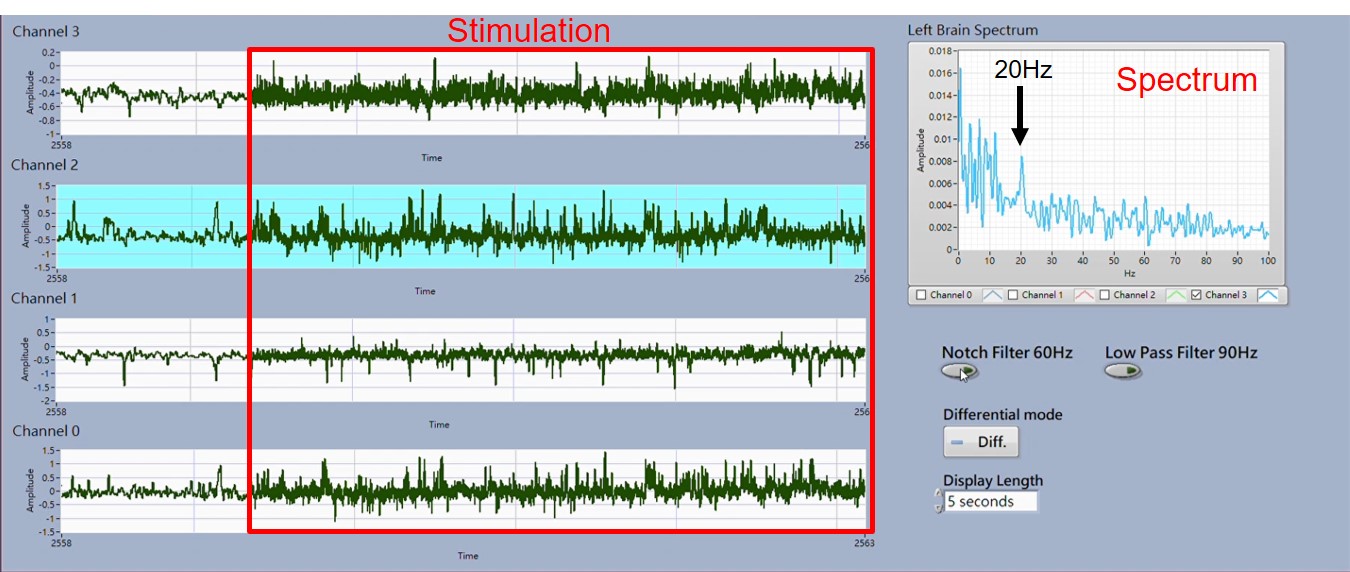Category: Parkinson's Disease: Neurophysiology
Objective: To develop and validate a real-time stimulus artifact removal analog front-end (AFE) by synchronized sample-and-hold artifact blanking (SSAB) technique with the Parkinsonian minipig model for closed-loop deep brain stimulation (DBS) application.
Background: Closed-loop DBS is a treatment to reduce the side effects of overstimulation in patients with Parkinson’s disease by adjusting stimulation parameters based on symptom-related biomarkers. Abnormal local field potential (LFP) in the subthalamic nucleus (STN) can be feedback control for closed-loop DBS. However, the scale of LFP is in the microvolt range, while the stimulus intensity is in the volt range. This presents a significant challenge in the design of the AFE as it needs to keep the LFP signal from being saturated and avoid artifacts during stimulation.
Method: The SSAB technique utilizes a biomedical signal processor to synchronize control of the AFE and stimulator. The detection circuit is temporarily closed to avoid amplifier output saturation during stimulation. The detected signal is stored on the capacitor at the amplifier input before turning off the detection circuit. Once stimulation is complete, the detection circuit is turned back on, and the amplifier returns to normal quickly [1]. After implanting the DBS lead into the STN of a Parkinsonian minipig [2], LFP was measured with and without stimulation using the SSAB AFE.
Results: During DBS, a biphasic square wave with a frequency of 130Hz, a pulse width of 60μs, and an intensity of 3.6mA current stimulation is used. In the absence of stimulation, the measured LFP is approximately 150μV. During stimulation, the measured amplitude is about 480μV with SSAB and over 2V without SSAB. The spectral results using SSAB remain unaffected by the stimulation. The detected signals using SSAB maintain high continuity and accuracy [figure1].
Conclusion: SSAB has been successfully implemented, and its effectiveness has been verified in large animals. SSAB does not require additional compensation and comparator circuits, so the extra power consumed will be almost negligible. Therefore, SSAB is suitable for implantable closed-loop DBS.
LFP of Parkinsonian pig with SSAB and its spectrum
References: [1] Huang CW, Lai CK, Hung CC, Wu CY, Ker MD. A CMOS synchronized sample-and-hold artifact blanking analog front-end local field potential acquisition unit with ±3.6-V stimulation artifact tolerance and monopolar electrode-tissue impedance measurement circuit for closed-loop deep brain stimulation SoCs. IEEE Trans Circuits Syst I Regul Pap 2023;70(6):2257-2270.
[2] Lin HC, Wu YH, Huang CW, Ker MD. Verification of the beta oscillations in the subthalamic nucleus of the MPTP-induced parkinsonian minipig model. Brain Res 2023; 1798:148165.
To cite this abstract in AMA style:
YH. Wu, HC. Lin, CW. Huang, CC. Hsieh, MD. Ker. Real-Time Removal of Stimulus Artifact for Closed-Loop Deep Brain Stimulation by Synchronized Sample-And-Hold Artifact Blanking (SSAB): Verification in Animal Model [abstract]. Mov Disord. 2024; 39 (suppl 1). https://www.mdsabstracts.org/abstract/real-time-removal-of-stimulus-artifact-for-closed-loop-deep-brain-stimulation-by-synchronized-sample-and-hold-artifact-blanking-ssab-verification-in-animal-model/. Accessed October 17, 2025.« Back to 2024 International Congress
MDS Abstracts - https://www.mdsabstracts.org/abstract/real-time-removal-of-stimulus-artifact-for-closed-loop-deep-brain-stimulation-by-synchronized-sample-and-hold-artifact-blanking-ssab-verification-in-animal-model/

